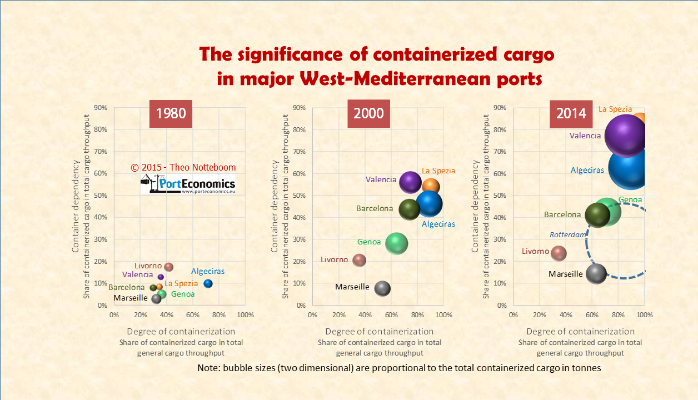By Theo Notteboom
In last week’s infographic, Theo Notteboom analysed the container dependency of major North-European ports. But how is the situation in southern Europe? How dependent are West-Mediterranean ports on container traffic?
As before, there are three dimensions in the infographic. The vertical axis shows the container dependency or the share of container throughput in the total throughput of the port. The horizontal axis depicts the degree of containerization or the share of containerized cargo in the total general cargo traffic of the port (i.e. total traffic minus liquid and dry bulk traffic). The two-dimensional size of the bubbles is proportional to the containerized cargo volume of the port expressed in tonnes. The bubble for Rotterdam, Europe’s largest container port, was added in the 2014 figure for reference purposes only.
Marseille and Livorno combine a moderate degree of containerization with a rather low container dependency. Livorno’s position hardly changed during the period of observation. Algeciras, but particularly Valencia and La Spezia, have seen the strongest push towards the upper right corner: they have witnessed a rapid development towards a higher container dependency and high degree of containerisation. The strong development of the container transhipment business is a major driver behind the fast changing positions of Algericas and Valencia. Genoa and Barcelona hang somewhat in the middle. While Genoa gradually moved from the bottom left corner to the middle of the graph, Barcelona initially rose fast, but saw a modest move away from the upper right corner after the start of the economic crisis. At present, Barcelona’s container dependency and degree of containerization is lower than 15 years ago, which is quite exceptional compared to other major ports in Europe. Note that the figures only relate to freight. The cruise business is not included and this happens to be a key market for Barcelona.
For further information on the containerization of commodities: Rodrigue, J.-P., Notteboom, T. (2014), Looking inside the box: evidence from the containerization of commodities and the cold chain. Maritime Policy and Management, vol. 42, no. 3, pp. 207-227.













